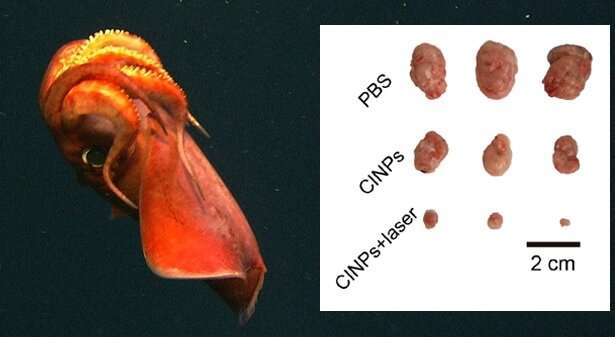July 22, 2019 feature
Cuttlefish ink found promising for cancer treatment

Researchers have found that cuttlefish ink—a black suspension sprayed by cuttlefish to deter predators—contains nanoparticles that strongly inhibit the growth of cancerous tumors in mice. The nanoparticles consist mostly of melanin by weight, along with amino acids, monosaccharides (simple sugars), metals, and other compounds. The researchers showed that the nanoparticles modify the immune function in tumors, and when combined with irradiation, can almost completely inhibit tumor growth.
The researchers, led by Pang-Hu Zhou at the Renmin Hospital of Wuhan University and Xian-Zheng Zhang at the Chemistry Department at Wuhan University, have published a paper on the ability of nanoparticles from cuttlefish ink to inhibit tumor growth in a recent issue of ACS Nano.
"We found natural nanoparticles from cuttlefish ink with good biocompatibility that can effectively achieve tumor immunotherapy and photothermal therapy simultaneously," Zhang told Phys.org. "This finding might inspire more exploration of natural materials for medical applications."
Tumor immunotherapy involves fighting cancer by stimulating the body's own immune system. One strategy is to target leukocytes, or white blood cells. Macrophages are the predominant leukocyte found in some tumors, and they can take one of two forms: M1 or M2. The M1 phenotype engulfs and destroys tumor cells through the process of phagocytosis and with the activation of T cells (other white blood cells). In the M2 phenotype, on the other hand, this immune function is suppressed, allowing tumor growth to continue unchecked. In tumor environments, the M2 phenotype almost always outnumbers the M1 phenotype.
Recently, researchers have been working on the development of small molecules and antibodies that can convert protumor M2 macrophages to antitumor M1 macrophages. At the same time, they are designing nanoparticles such as photothermal agents that, when exposed to irradiation, locally destroy cancer cells by thermal ablation. These agents can be integrated into synthesized nanoparticles, and then potentially administered to patients. One of the drawbacks, however, is that these synthetic nanoparticles are expensive and require complicated preparation methods.
Due to these costs, some researchers have turned to nature for alternatives. Previous research has shown that certain natural compounds, including those found in brown algae and some bacteria, contain polysaccharides that have the ability to reprogram macrophages from the M2 type to the M1 type.
In the new paper, the researchers found that cuttlefish ink nanoparticles, which are spherical and approximately 100 nm in diameter, also have this ability. After confirming the biocompatibility of these nanoparticles, the researchers performed several experiments both in vitro with tumor cells and in vivo with tumor-afflicted mice. In the in vitro experiments, the researchers found that irradiating the nanoparticles with near-infrared irradiation killed approximately 90% of tumor cells, although the nanoparticles displayed almost no cytotoxicity without irradiation. The researchers explained that the high melanin content of the nanoparticles plays a key role in the irradiation process, as melanin has an intrinsically good photothermal conversion ability.
In mice, nanoparticle treatment proved to be effective both alone and in combination with irradiation, although irradiation further improved the outcome. Bioluminescent imaging revealed that treated mice exhibited significantly lower tumor bioluminescence compared to controls, indicating greatly reduced metastases on internal organs. Mice treated with both nanoparticles and irradiation exhibited a nearly complete inhibition of tumor growth.
By performing a gene analysis, the researchers identified 194 differentially expressed genes involved in immune functions that were associated with the regulation of the inflammatory response and cell killing, and which were either up- or down-regulated by the treatment. The analysis indicated that a certain signaling pathway is responsible for the conversion of M2 macrophages to M1 macrophages. This mechanism not only leads to phagocytosis of tumor cells, but also stimulates the immune system to produce various antitumor factors, all of which play a role in inhibiting tumor growth.
In the future, the researchers plan to explore other natural materials that have anti-cancer properties.
"Our research team is currently studying the biomedical potential of natural materials such as hair, cuttlefish ink, bacteria, fungi, and even the cells of the human body as a therapeutic drug carrier," Zhang said. "By drawing inspiration from nature and taking advantage of its own characteristics, we expect to find some valuable research that will provide new and effective solutions for the treatment of clinical diseases."
More information: Rong-Hui Deng. Mei-Zhen Zou, Diwei Zheng, Si-Yuan Peng, Wenlong Liu, Xue-Feng Bai, Han-Shi Chen, Yunxia Sun, Pang-Hu Zhou, and Xian-Zheng Zhang. "Nanoparticles from Cuttlefish Ink Inhibit Tumor Growth by Synergizing Immunotherapy and Photothermal Therapy." ACS Nano. DOI: 10.1021/acsnano.9b02993
Journal information: ACS Nano
© 2019 Science X Network





















